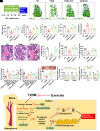Exercise-Linked Skeletal Irisin Ameliorates Diabetes-Associated Osteoporosis by Inhibiting the Oxidative Damage-Dependent miR-150-FNDC5/Pyroptosis Axis
- PMID: 35802043
- PMCID: PMC9750954
- DOI: 10.2337/db21-0573
Exercise-Linked Skeletal Irisin Ameliorates Diabetes-Associated Osteoporosis by Inhibiting the Oxidative Damage-Dependent miR-150-FNDC5/Pyroptosis Axis
Abstract
Recent evidence suggests that physical exercise (EX) promotes skeletal development. However, the impact of EX on the progression of bone loss and deterioration of mechanical strength in mice with type 2 diabetic mellitus (T2DM) remains unexplored. In the current study, we investigated the effect of EX on bone mass and mechanical quality using a diabetic mouse model. The T2DM mouse model was established with a high-fat diet with two streptozotocin injections (50 mg/kg/body wt) in C57BL/6 female mice. The diabetic mice underwent treadmill exercises (5 days/week at 7-11 m/min for 60 min/day) for 8 weeks. The data showed that diabetes upregulated miR-150 expression through oxidative stress and suppressed FNDC5/Irisin by binding to its 3'-untranslated region. The decreased level of irisin further triggers the pyroptosis response in diabetic bone tissue. EX or N-acetyl cysteine or anti-miRNA-150 transfection in T2DM mice restored FNDC5/Irisin expression and bone formation. Furthermore, EX or recombinant irisin administration prevented T2DM-Induced hyperglycemia and improved glucose intolerance in diabetic mice. Furthermore, osteoblastic knockdown of Nlrp3 silencing (si-Nlrp3) or pyroptosis inhibitor (Ac-YVADCMK [AYC]) treatment restores bone mineralization in diabetic mice. Micro-computed tomography scans and mechanical testing revealed that trabecular bone microarchitecture and bone mechanical properties were improved after EX in diabetic mice. Irisin, either induced by skeleton or daily EX or directly administered, prevents bone loss by mitigating inflammasome-associated pyroptosis signaling in diabetic mice. This study demonstrates that EX-induced skeletal irisin ameliorates diabetes-associated glucose intolerance and bone loss and possibly provides a mechanism of its effects on metabolic osteoporosis.
© 2022 by the American Diabetes Association.
Figures






Comment in
-
Irisin: The Bony Builder Flexes Its Muscles.Diabetes. 2022 Dec 1;71(12):2486-2489. doi: 10.2337/dbi22-0023. Diabetes. 2022. PMID: 36409786 No abstract available.
References
Publication types
MeSH terms
Substances
Grants and funding
LinkOut - more resources
Full Text Sources
Medical

